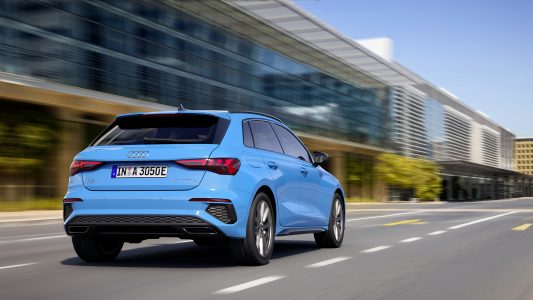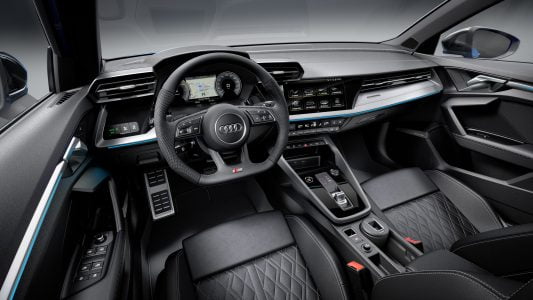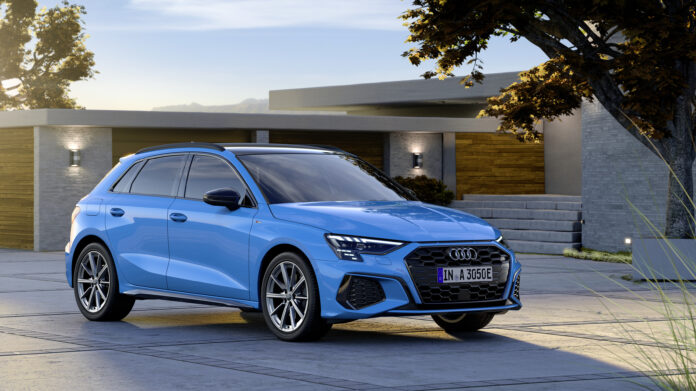With the A3 Sportback 40 TFSI e , Audi is continuing its electrification offensive. The plug-in hybrid models from the A6, A7, A8, Q5, and Q7 product lines have already been introduced on the markets. Now, the compact models are following suit. The Audi A3 Sportback 40 TFSI e, which took up the concept of its successful predecessor, the A3 Sportback e-tron, and further optimized it, will kick things off. A more powerful variant that emphasizes the sporty accents will follow shortly after.
A 1.4 TFSI serves as the combustion engine for the compact plug-in hybrid model. The four-cylinder gasoline engine outputs 110 kW (150 PS) and delivers more than 250 Nm (184.4 lb-ft) of torque in the range between 1,550 and 3,500 rpm. The electric drive is powered by a permanently excited synchronous machine with an increased power density as compared to its predecessor. It produces 80 kW and 330 Nm (243.4 lb-ft) of torque. As with the predecessor, it is integrated in the housing of the six-speed S tronic. However, it is even lighter and more compact.
Together, the 1.4 TFSI and the electric motor deliver a system output of 150 kW (204 PS). When working together with maximum boost, the system torque reaches 350 Nm (258.1 lb-ft). The compact plug-in hybrid model sprints from 0 to 100 km/h (62.1 mph) in 7.6 seconds on its way to a top speed of 227 km/h (141.1 mph). In the NEDC cycle, it consumes between 1.5 and 1.4 liters of fuel per 100 kilometers (156.8–168.0 US mpg), which corresponds to 34 to 30 grams of CO2 per kilometer (54.7–48.3 g/mi). A six-speed S tronic transfers the torques of the motor and engine to the front axle. The dual-clutch transmission is equipped with an electric oil pump that ensures gear changes and oil supply even when the TFSI is deactivated temporarily.
The lithium-ion battery is located below the vehicle underbody in the area of the rear sears of the Audi A3 Sportback 40 TFSI e. Its 96 prismatic cells store 13.0 kWh of energy, almost 48 percent more than the predecessor model. No changes were made to the high-voltage battery in the package; the progress results from the improved cell chemistry. A separate cooling circuit controls the temperature of the battery. It can also be coupled with the air conditioning system, if necessary. This allows customers to drive on electric power even at higher outside temperatures.

The drive management of the compact plug-in hybrid is designed for efficient driving. It always starts electrically, up to a temperature of -28 °C. Drivers can prioritize electric drive with the EV button. It can cover up to 78 kilometers (48.5 mi) (according to the NEDC standard, 67 kilometers (41.6 mi) in the WLTP), that is the majority of everyday journeys, with zero local emissions. That is almost 20 kilometers (12.4 mi) more than the predecessor model. The fully electric top speed is 140 km/h (87.0 mph). At low speeds, the statutory e-sound of what is known as the Acoustic Vehicle Alert System is output.
When the A3 PHEV is in hybrid mode, the two drives divide the work intelligently. Two special modes can be selected via the MMI operating system: “Battery hold” and “Battery charge.” In “hold” mode, the available battery charge is held at the current level. In “charge” mode, as much electricity as possible is supplied to the battery.
The drive management of the Audi A3 Sportback 40 TFSI e uses a large volume of data that the navigation, sensors, and assist systems supply. In the interest of efficiency, it selects freewheeling with deactivated TFSI in most situations when decelerating, allowing the car to coast.
To influence the character of the drive, as well as other systems such as power steering and S tronic, drivers can also use the standard Audi drive select system. It offers the driving profiles comfort, auto, dynamic, and individual. In the dynamic profile and when the S tronic is set to S gear, the hybrid drive shows off its sporty potential. When the driver puts the pedal to the metal via kickdown, it releases the full boost torque for up to ten seconds. As soon as they take their foot off the accelerator pedal, the electric motor switches to recuperation. The resulting deceleration creates a true one-pedal feeling.

While braking, the electric motor performs the deceleration alone up to around 0.3 g, thereby covering the vast majority of all brake applications in everyday customer driving. The hydraulic wheel brakes only come into play if the driver presses the pedal more forcefully. The transition is almost unnoticeable, and recuperation remains active. While braking, the electric motor can recover up to 40 kW of energy. The suspension of the Audi A3 Sportback 40 TFSI e combines pleasant ride comfort and a good level of dynamism; the sophisticated four-link rear axle provides an excellent basis for this. The electric brake booster guarantees powerful and spontaneous braking. Specially designed 16-inch alloy wheels come as standard, and Audi delivers 17-inch or 18-inch wheels upon request.
Audi delivers the compact plug-in hybrid with a 230-volt power charging cable for the garage as standard. The Audi A3 Sportback 40 TFSI e charges with a maximum power of 2.9 kW. It takes slightly more than four hours to fully recharge a completely empty battery. With the free myAudi app, customers can control the charging times and pre-entry climate control remotely. When outside temperatures are low, electric heating elements warm up the interior, while the electrically powered air conditioning cools the interior down when outside temperatures are high. At public charging terminals, the car charges via what is known as a mode 3 cable. The e-tron Charging Service makes charging on the road particularly convenient. It covers most countries in Europe, and a single card offers access to roughly 150,000 charging points.
Audi A3 Sportback 40 TFSI e will go on sale in many European markets in the fall of 2020. Its base price in Germany is EUR 37,470.92, and customers in Germany are entitled to incentives** in the amount of EUR 6,750. As a company car, the plug-in hybrid model is taxed only at a flat rate of 0.5% of the gross list price.


